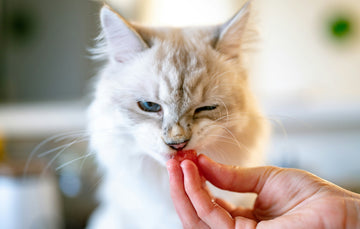Does your cat scarf down food like they’re racing the clock? You’re not alone. Many cat owners wonder why their sweet, fluffy companion suddenly transforms into a furry vacuum cleaner at mealtime.
Fast eating might look harmless—or even a little funny—until you’re cleaning up regurgitated kibble again. But beyond being inconvenient, eating too quickly can cause serious health problems, from digestive issues to obesity. The good news? Understanding the root cause can help you turn frantic mealtimes into calm, healthy routines.
Here are seven common reasons why cats eat too fast, along with practical tips to help them slow down and enjoy their food:
-
Food competition or territorial behavior
If you have more than one pet, your cat may feel the need to finish before anyone else can steal their food. Even if the other pets don’t touch their bowl, just the presence of a “leader” animal can create subtle pressure. Their survival instinct kicks in: eat fast or go hungry. -
Emotional eating: boredom, stress, or loneliness
Like people, cats sometimes eat not out of hunger but out of boredom or stress. Changes in their environment—moving homes, a new pet, or even small shifts in routine—can trigger emotional eating. If your cat’s appetite fluctuates with their mood, it’s worth looking deeper. -
Underlying medical problems
An unusually strong appetite can be a warning sign. Conditions like hyperthyroidism or diabetes may cause your cat to feel hungry all the time. If your cat has suddenly started gulping down food, a vet visit and bloodwork are in order. Better safe than sorry. -
Past trauma or food insecurity
Rescue cats or those with difficult pasts may have learned that food isn’t always guaranteed. Even in a safe, loving home, that survival mindset can linger. Their instincts say: finish it now, before it disappears. With time, patience, and consistent feeding routines, this behavior often softens. -
Poor-quality diet
If their food lacks essential nutrients, cats may eat more to compensate. Fillers, grains, and artificial additives may fill their stomachs but not their nutritional needs. A high-quality, balanced diet can help regulate appetite and slow down eating. -
Parasites
Intestinal parasites like tapeworms steal nutrients directly from your cat’s system, leaving them hungry no matter how much they eat. If you notice signs like scooting, visible segments in stool, or constant hunger, deworming treatment is essential. -
They simply love the taste
Sometimes the simplest explanation is the right one: your cat just loves the food. Flavor, texture, or smell can drive their enthusiasm. While that’s cute, it still doesn’t mean scarfing it down is healthy. Offering variety—mixing wet and dry food, or rotating brands—can help take the edge off their excitement.
Once you know why your cat eats so fast, the next step is gently guiding them toward healthier habits. Here are some proven ways to help:
-
Try puzzle feeders or slow-feeding toys
Turn mealtime into a game so your cat has to work for their food. Puzzle feeders make them use their paws and brains, stretching out the eating process. Many owners find treat-dispensing toys work wonders—for example, Bobopal’s interactive toys combine fun and feeding without making mealtime a chore. -
Add enrichment throughout the day
Many cats eat out of boredom. Give them vertical climbing spaces, engaging toys, or short play sessions to keep their minds busy. A bored cat eats quickly, but a mentally stimulated cat eats slower and stays curious. -
Feed smaller, more frequent meals
If you only feed once or twice a day, try splitting meals into smaller portions. Frequent, smaller meals reduce hunger-driven urgency and help them feel more satisfied. -
Use an automatic feeder
Timed feeders with portion control can regulate pace and remove the “human factor” that sometimes creates food-related excitement or anxiety. -
Spread food out on a flat surface
Bowls make it easy to gulp. Spreading food on a plate or in a muffin tin forces your cat to take their time and “hunt” for bites.
Every cat is different. What works for one may not work for another. Observe, experiment, and stay patient. Often, a combination of strategies is what brings lasting success.
Fast eating may look quirky, but left unchecked it can create risks. Whether your cat is stressed, bored, recovering from trauma, or just head-over-heels for tuna, the good news is that there are many ways to guide them toward healthier eating habits.
Start with a vet check to rule out medical issues. Then, provide nutrient-rich food, spread out their meals, and let them work for their dinner. Not only will this improve digestion, but it will also add enrichment, challenge, and fun to their daily life—which every cat deserves.






